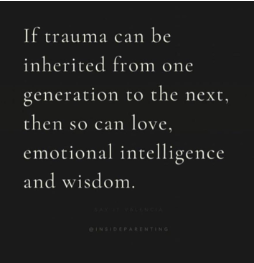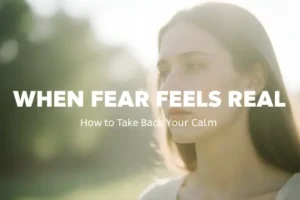New Ways to Embrace our emotions | In our complex lives, we face numerous stressors such as work demands, juggling responsibilities, managing time and finances, and coping with rapid changes. As humans, we can navigate many of those stressors when we have a haven to retreat to at the end of the day. When we can call a friend or a loved one and say, “I had a pretty tough day, can I tell you about it?” or get a gentle hug or a word of encouragement. That’s why you’ll often hear us, as Marriage and Family therapists, emphasize the concept of “emotional safety” – because it’s the cornerstone of what we all yearn for and need in our lives.
However, many of us did not grow up in families where emotions were openly discussed and where vulnerability was displayed. There are many reasons why emotional safety might not be present within families. Different factors, such as cultural expectations, societal and gender stereotypes, trauma, grief, and loss, can result in families and individuals having to suppress their emotions rather than having the tools and space to openly share them. Oftentimes, it is an experience that starts in childhood and continues throughout adolescence into adulthood. When beginning the therapeutic journey, I am often curious about people’s childhood experiences and frequently ask questions such as, “Who did you turn to for comfort during times of distress?” Sadly, the responses often reveal a lack of support: “I had no one to turn to,” “I faced it alone,” or “I felt unable to share my pain.” This reality highlights why attachment theory informs much of our therapeutic approach, as it sheds light on the relational dynamics we’ve internalized and the crucial work of cultivating emotional safety and connection.
Attachment theory suggests that early interactions with caregivers shape our patterns of emotional connection throughout life. It emphasizes the importance of a secure bond between infants and caregivers for healthy psychological development. These early relationships influence how individuals form and maintain relationships later in life, impacting their sense of security, trust, and ability to regulate emotions. However, when children lack the space to express and articulate their emotions, they often resort to hiding, distraction, or numbing their pain. This suppression can lead to the emergence of unhealthy coping mechanisms and disrupt their relationship patterns as the unexpressed pain continues to impact their emotional landscape.
The question then becomes – What to do as an adult who grew up in a family and environment where there was little to no space for your emotions?
- Know that you are not alone: When we do not learn to express our emotions, we feel isolated and alone in our pain. Our road map for dealing with pain becomes one that is far too familiar. We follow the narrative that tells us that our pain and emotions are a burden to others or that we might be judged if we show how we are truly feeling. This makes sense when you spend years bearing your pain on your own. I just want you to know from my experience as a mental health professional who witnessed this pattern while working with many different individuals, couples, and families but more importantly as a fellow human – you are definitely not alone in this struggle!
- It is okay to grieve not having that emotional safety as a child: Sometimes there is grief and pain that comes along with doing the work in therapy to understand why certain patterns exist and recur in our lives. It can be really difficult to turn to our inner child and recognize that they were carrying a lot of pain and had nowhere to put down that pain and no one to turn to, but I promise you that there is also healing and insight on the other side of that brave journey of turning inward and facing the pain.
- Love and connection come in many different forms: The media, culture and many different factors influence how we view connection in our relationships, but the reality is that love, care, and connection can exist in many different forms. There are people who do not verbalize “I love you” often but who are here for you every birthday, every graduation, every milestone, and every time your car breaks down. There are families, whether they are families of origin or chosen families, who do not tell you how much they care about you or appreciate you, but they cook your favorite meal every time you visit from out of town. It is completely okay and normal to grieve that lack of verbal expression of connection AND also to recognize that different families and different cultures can express love and care differently.
- It is difficult to feel and express emotions when you are in survival mode: Think about this: you are stranded in a forest, it is dark and you have been on your feet walking, trying to find your way and then you hear a terrifying voice coming behind you, you do not stop or turn to see what is coming, you just keep running! Do you think you would be likely to stop for a minute and say “Wow, this is terrifying, I feel really scared and lost right now.” Probably not! This is what it feels like to live in survival mode. A lot of families struggle with different stressors such as health struggles, mental health illnesses, addiction, financial stress, immigration, trauma, deployment, and many different other struggles. Those stressors can trigger a cycle of toxic stress and survival that becomes increasingly difficult to change or exit. So, it is important for us to honor the paths that people took to survive the challenges life threw at them AND also recognize that some strategies can result in unhealthy patterns and cycles.
- You can understand the patterns AND choose to create new ones: Approaching emotional safety from a perspective where we extend empathy and curiosity to the parts of ourselves and the environments that we grew up in instead of approaching it from a judgmental perspective, can be a challenging yet rewarding journey. It helps hold space for the pain that resulted from the absence of emotional safety while also holding compassion and empathy for the different reasons those cycles emerged and continued over generations. We can allow ourselves space to understand and grieve those patterns while also choosing to create new ones that involve awareness, compassion, and emotional safety within our relationship with self and others.




